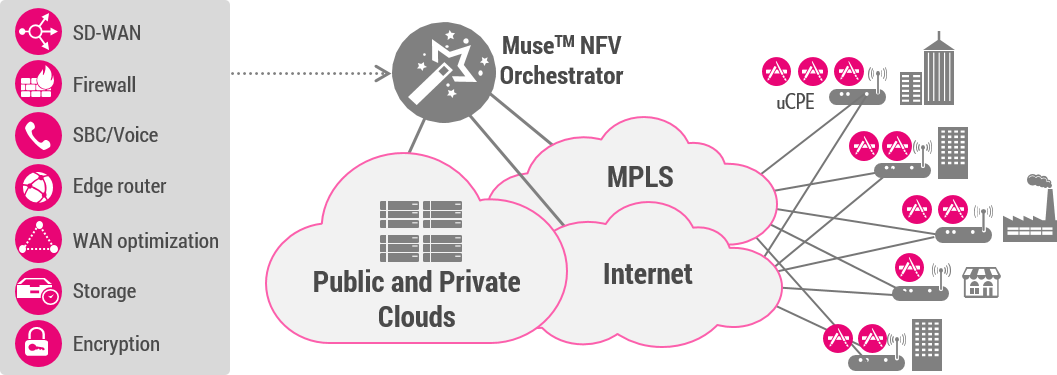SD-WAN on uCPE
Inevitable or a passing trend?
In the 1970s, there was a brief episode in the history of office automation dominated by specialized word processing machines. Typewriters gave way to workstations with clunky monitors, electronic keyboards, large floppy disk drives, and printers, all controlled by dedicated software. It was the start of a revolution. No longer was it necessary to craft handwritten text meticulously into its final form before being handed to the typewriter typist. Instead, a handwritten draft could be prepared quickly, entered by an operator into the word processing machine, and then revised endlessly by marking up the printed output. Productivity soared, as did the amount of documentation produced.
Today, we are in the midst of a similar phenomenon, taking place in the world of business communications. Businesses are undergoing digital transformation. As a part of this process, Enterprises and SMBs are moving their business applications into The Cloud in an overwhelming way. The Global Cloud index forecasts that: “By 2021, 94 percent of workloads and compute instances will be processed by cloud data centers.”
This impacts wide area network (WAN) traffic, which in the past, ran primarily between business locations over SLA-guaranteed VPNs. In a digitally transformed world, WAN traffic still originates at business locations, but terminates both in private clouds, often located in corporate headquarter data centers for security reasons, and in public clouds. This traffic includes: a) interactions between end-users and cloud-based applications software; b) data storage applications, including multi-site backup, running autonomously between data centers; and, c) vertical communications applications, like voice and video running over the WAN.
The net effect is higher business costs, due to more WAN traffic and greater complexity of managing WAN resources. The response has been the emergence of software defined WANs (SD-WANs), which provide businesses with visibility and granular control over their WAN traffic.
SD-WANs allow businesses to create and manage policies that distribute traffic between higher-cost dedicated MPLS facilities and lower-cost shared broadband facilities. Typically, high-priority and low-latency applications, like Salesforce, Skype and business applications, are routed over MPLS facilities. Applications like web browsing are directed to broadband. Traffic distribution decisions are updateable anytime, based on factors like traffic load, facility availability, and application priority. The benefit of SD-WANs is continuously optimizing WAN resources to match business needs, providing the best balance between performance and cost.
You may ask, what does this have to do with word processing machines in the 1970s. Well it just so happens that the first generation of SD-WAN solutions were based on, you guessed it, specialized, dedicated appliances. These appliances, located on the business premises had three basic physical interfaces: one to the business LAN, one for dedicated MPLS network connectivity, and one for shared broadband network connectivity. The box also had a logical interface to an SD-WAN controller that monitored WAN traffic and instructed specialized software in the SD-WAN box how to allocate traffic from the LAN to either of the WAN interfaces.
However, it just so happens, that while SD-WAN is revolutionary and growing rapidly, it is not the only business communication application. Other ones include packet routing, security firewalls and intrusion protection systems, session border control for voice communications, denial of service attack protection (DDoS), encryption, and storage networking applications. Each of these applications also typically ran on their own dedicated appliances, known as customer premises equipment (CPE).
What is happening in parallel to the SD-WAN boom, is the emergence of a “universal” approach to CPE, called uCPE. In an almost identical fashion to the emergence of the personal computer forty years ago, uCPE is a general-purpose platform for business communications services. It is equipped with a wide array of fixed and wireless communications interfaces facing inwards to the business and outwards to the network, powerful processors, and an operating system tuned for running business communications applications.
What uCPE does, is allows SD-WAN and other business communications applications to be run as virtual software applications on top of the uCPE operating system. Best of all, uCPE allows multiple applications to run in parallel. This provides communication service providers with an excellent opportunity to fuse together virtualized delivery of SD-WAN, along with a customizable suite of business communication services, all running on an uCPE platform. This produces a unique win-win for businesses and service providers. Businesses obtain a one-stop shop for all their business communication services, which they can select and modify on-demand as their needs change. SPs increase customer satisfaction and stickiness, while developing a pipeline for value-added service revenues.
Ribbon is betting on the inevitability of this approach with our Muse™ suite of virtualized business communications services, delivering SD-WAN plus more on uCPE, for enterprises and small and medium businesses.





